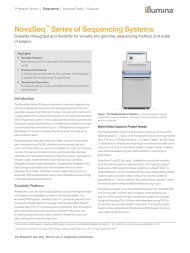Abstracts
ngsfinalprogram
ngsfinalprogram
You also want an ePaper? Increase the reach of your titles
YUMPU automatically turns print PDFs into web optimized ePapers that Google loves.
Poster <strong>Abstracts</strong><br />
route reconstruction. For the purpose of reconstructing<br />
putative transmission routes, a<br />
variety of phylogeny building methods have<br />
been developed and can help identify potential<br />
transmission events within a hospital environment.<br />
Method: We sequenced 149 E. faecium<br />
isolates of MLST type ST736 from 106 patients<br />
over 55 months at Westchester Medical<br />
Center, and reconstructed phylogenies on the<br />
samples with various distance based methods.<br />
To construct the phylogenies, we used a variant<br />
calling pipeline to determine likely SNPs<br />
within the samples, and then we applied various<br />
filters to remove inaccurate SNPs, such<br />
as removing SNPs in repetitive regions and<br />
phage regions. Afterwards, a pairwise distance<br />
matrix was built based on the SNP calls, and<br />
finally, we applied various phylogeny building<br />
methods to the distance matrix. The methods<br />
we experimented with were neighbor-joining,<br />
maximum likelihood, and Prim’s (undirected)<br />
and Edmond’s (directed) minimum spanning<br />
tree (MST) algorithms. The results of these<br />
methods were then compared to each other to<br />
determine how robust and accurate our results<br />
may be. Lastly, we also evaluated how frequently<br />
antibiotic resistance increased along<br />
the predicted transmission events in our tree.<br />
Results: The trees we generated mostly have<br />
good concordance with each other often with<br />
more than 80% of subtrees matching between<br />
results. Additionally, we also computed how<br />
frequently antibiotic resistance increased along<br />
transmissions suggested by the MST methods.<br />
Both MST methods showed that antibiotic<br />
resistance generally increased along transmission<br />
edges in the trees, and Edmond’s directed<br />
MST method showed a higher percentage of<br />
the predicted transmission events resulting in<br />
increased daptomycin resistance, with about<br />
3/4 of transmissions indicating an increase in<br />
resistance. As we expect resistance to increase<br />
as transmissions occur, this may indicate that<br />
Edmond’s directed MST produced a more<br />
accurate tree. Conclusion: Our preliminary<br />
results show that Edmond’s directed MST may<br />
produce an accurate phylogeny tree, although<br />
further verification may be needed, as other<br />
methods yield slightly different trees. In the future,<br />
we plan to examine clinical data in order<br />
to help validate the correctness of the transmissions<br />
predicted by our phylogeny trees.<br />
n 19<br />
ANALYSIS OF AN ENTEROVIRUS D68<br />
OUTBREAK THROUGH METAGENOMIC<br />
SEQUENCING<br />
H. Lin 1 , Q. Wan 1 , W. Huang 2 , G. Wang 2 , J.<br />
Zhuge 2 , S. M. Nolan 2 , J. T. Fallon 2 , N. Dimitrova<br />
1 ;<br />
1<br />
Philips Research North America, Briarcliff<br />
Manor, NY, 2 New York Medical College, Valhalla,<br />
NY.<br />
Background: Metagenomic sequencing can be<br />
used to detect the presence of microbial organisms.<br />
Many metagenomic techniques have<br />
been developed to explore and verify microbial<br />
ecology, evolution and diversity, especially for<br />
investigating infectious viruses and bacteria.<br />
By obtaining the population distribution of<br />
classified microbial genomes in certain samples,<br />
metagenomic tools have the potential to<br />
provide insights into the causality of infectious<br />
disease outbreaks. During the Enterovirus D68<br />
outbreak in 2014, 93 nasopharyngeal swab<br />
samples were obtained from patients with<br />
symptoms of respiratory infection and were<br />
sequenced at Westchester Medical Center.<br />
Methods: We used Kraken for the purpose of<br />
classifying reads based on taxonomic orders.<br />
By using Kraken, microbial reads can be identified<br />
and subsequently enable the investigation<br />
of certain infectious disease outbreak. To<br />
obtain the best performance from Kraken, we<br />
build a pipeline to automatically fetch publicly<br />
available reference genomes from NCBI at<br />
user’s demand to keep Kraken’s classification<br />
results up-to-date for detecting pathogens present<br />
within a sample. The pipeline is not only<br />
able to extract reads by viruses, bacteria, and<br />
fungi species, but can also generate aggregate<br />
analysis indicating the most prevalent microorganisms<br />
within any taxonomic group. We also<br />
provide analysis about possible cohabitations<br />
ASM Conference on Rapid Next-Generation Sequencing and Bioinformatic<br />
Pipelines for Enhanced Molecular Epidemiologic Investigation of Pathogens<br />
51



